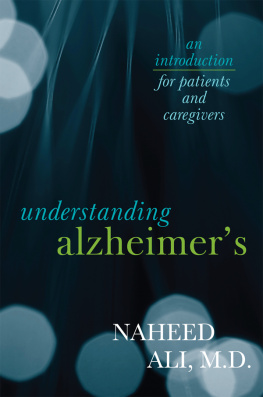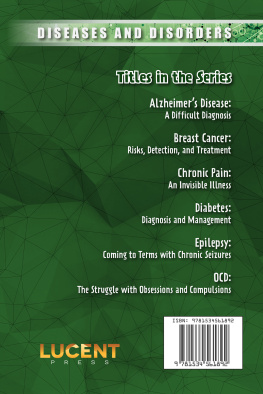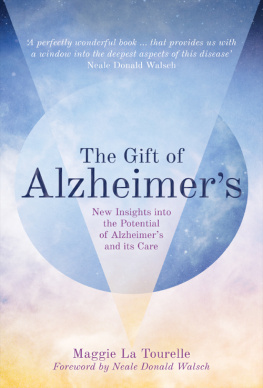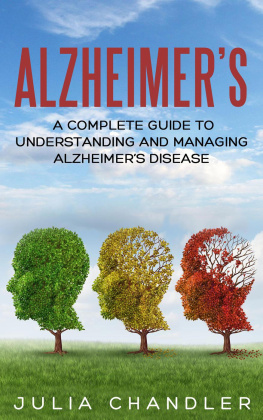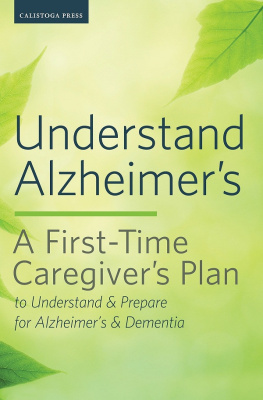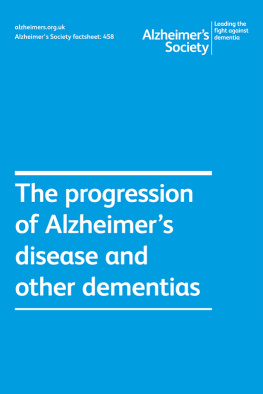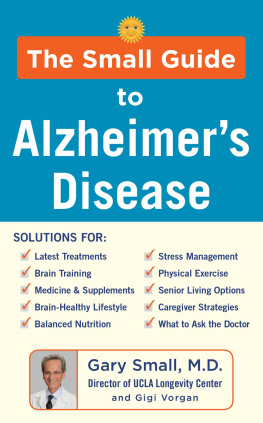Karl Herrup - How Not to Study a Disease : The Story of Alzheimers
Here you can read online Karl Herrup - How Not to Study a Disease : The Story of Alzheimers full text of the book (entire story) in english for free. Download pdf and epub, get meaning, cover and reviews about this ebook. publisher: MIT Press, genre: Romance novel. Description of the work, (preface) as well as reviews are available. Best literature library LitArk.com created for fans of good reading and offers a wide selection of genres:
Romance novel
Science fiction
Adventure
Detective
Science
History
Home and family
Prose
Art
Politics
Computer
Non-fiction
Religion
Business
Children
Humor
Choose a favorite category and find really read worthwhile books. Enjoy immersion in the world of imagination, feel the emotions of the characters or learn something new for yourself, make an fascinating discovery.

- Book:How Not to Study a Disease : The Story of Alzheimers
- Author:
- Publisher:MIT Press
- Genre:
- Rating:5 / 5
- Favourites:Add to favourites
- Your mark:
- 100
- 1
- 2
- 3
- 4
- 5
How Not to Study a Disease : The Story of Alzheimers: summary, description and annotation
We offer to read an annotation, description, summary or preface (depends on what the author of the book "How Not to Study a Disease : The Story of Alzheimers" wrote himself). If you haven't found the necessary information about the book — write in the comments, we will try to find it.
Karl Herrup: author's other books
Who wrote How Not to Study a Disease : The Story of Alzheimers? Find out the surname, the name of the author of the book and a list of all author's works by series.
How Not to Study a Disease : The Story of Alzheimers — read online for free the complete book (whole text) full work
Below is the text of the book, divided by pages. System saving the place of the last page read, allows you to conveniently read the book "How Not to Study a Disease : The Story of Alzheimers" online for free, without having to search again every time where you left off. Put a bookmark, and you can go to the page where you finished reading at any time.
Font size:
Interval:
Bookmark:
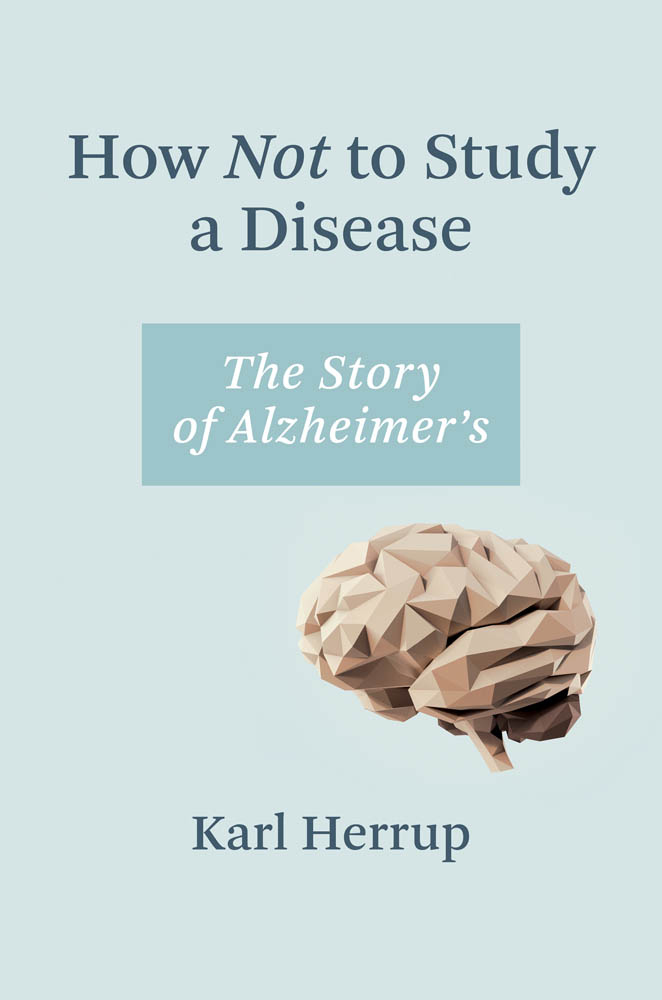
TO STUDYA DISEASE
THE STORY OF ALZHEIMERS
KARL HERRUP
THE MIT PRESSCAMBRIDGE, MASSACHUSETTSLONDON, ENGLAND
2021 Massachusetts Institute of Technology
All rights reserved. No part of this book may be reproduced in any form by any electronic or mechanical means (including photocopying, recording, or information storage and retrieval) without permission in writing from the publisher.
Library of Congress Cataloging-in-Publication Data
Names: Herrup, Karl, author.
Title: How not to study a disease : the story of Alzheimers / Karl Herrup.
Description: Cambridge, Massachusetts : The MIT Press, [2021] | Includes bibliographical references and index.
Identifiers: LCCN 2020040776 | ISBN 9780262045902 (hardcover)
Subjects: MESH: Alzheimer Disease | Models, Biological
Classification: LCC RC523 | NLM WT 155 | DDC 616.8/311--dc23
LC record available at https://lccn.loc.gov/2020040776
d_r0
This book is dedicated to Dorothy and her daughter and all of the millions of others whose lives have been touched by Alzheimers disease. It is you who bring me into work every day.
I dedicate this book as well to my teachers from whom I have learned so much and to all of my students who have taught me so much.
- The prevalence of disease changes with age for both cancer (gray bars) and Alzheimers disease (black bars). Cancer appears earlier in life and then reduces. Alzheimers is rare before age 65 after which time it steadily increases.
- Sources: Cancer data are fromhttps://gis.cdc.gov/Cancer/USCS/DataViz.html;Alzheimers data are fromhttp://www.bocsci.com/tag/alzheimer-s-disease-389.html.
- Global deaths attributed to dementia or Alzheimers disease (data are from World Health Organization analysis in 2011).
- Source: M. Yegambaram, B. Manivannan, T. G. Beach, and R. U. Halden, Role of Environmental Contaminants in the Etiology of Alzheimers Disease: A Review,Current Alzheimer Research12 (2015): 116146.
- Global life expectancy (data are from World Health Organization analysis in 2011).
- Sourcehttp://gamapserver.who.int/mapLibrary/Files/Maps/Global_LifeExpectancy_2008.png.
- Models of correlation, causality and coincidence. P/T, plaques/tangles; D, dementia;, unknown third factor. Groupings within dashed lines represent correlation; arrows represent causation.
- Central Dogma of Molecular Biology: DNA makes RNA makes protein.
- Amyloid beta (A) peptide and its location in the amyloid precursor protein (APP) parent protein.
- Early view of the causes of Alzheimers disease. APP, amyloid precursor protein; A, amyloid beta peptide.
- A diagram of the amyloid cascade hypothesis adapted from its original conception by Hardy and Higgins. APP, amyloid precursor protein; A, amyloid beta peptide.
- Source: J. A. Hardy and G. A. Higgins, Alzheimers Disease: The Amyloid Cascade Hypothesis,Science256 (1992): 184185.
- A diagram adapted from the revised amyloid cascade hypothesis as envisioned by Hardy and Selkoe in 2002. APP, amyloid precursor protein; PS1, presenilin-1; A, amyloid beta peptide.
- Source: J. Hardy and D. J. Selkoe, The Amyloid Hypothesis of Alzheimers Disease: Progress and Problems on the Road to Therapeutics,Science297 (2002): 353356.
- Myelin changes as a function of age and Alzheimers disease. Data replotted from source.
- Source: G. Bartzokis, J. L. Cummings, D. Sultzer, V. W. Henderson, K. H. Nuechterlein, and J. Mintz, White Matter Structural Integrity in Healthy Aging Adults and Patients with Alzheimer Disease: A Magnetic Resonance Imaging Study,Archives of Neurology60 (2003): 393398.
- NIH funding during the years 19902020.
- Source: Data are fromhttps://www.nih.gov/about-nih/what-we-do/nih-almanac/appropriations-section-2.
- National Institutes of Health budget authority 2018 and later estimates (in thousands of dollars). Note that neuroscience is by far the largest number in the table.
- Source: Data are fromhttps://www.nia.nih.gov/about/budget/fiscal-year-2020-budget/fy-2020-amounts-available-obligation.
- Distribution of research funding support.
- Source: Data are from National Science Board | Science & Engineering Indicators 2018.
- Comparison of federal- and industry-sponsored drug-related research.
- Source: GAO analysis of NSF Business Research, Development, and Innovation Survey Data I GAO-18-40.
- The price of Biogen stock during 2019.
- Relative sizes of the brains of mouse and human.
- Plaque densities in the brains of individuals with and without dementia.
- Source: Data are from B. E. Tomlinson, G. Blessed, and M. Roth, Observations on the Brains of Non-demented Old People,Journal of the Neurological Sciences7 (1968): 331356; B. E. Tomlinson, G. Blessed, and M. Roth, Observations on the Brains of Demented Old People,Journal of the Neurological Sciences11 (1970): 205242.
- Correlation, but not causality. All shapes within the large dashed-line box are correlated. No arrows between the shapes indicates that there are no paths of causality from one shape to another. P/T, plaques/tangles; D, dementia; GVD, granulovacuolar degeneration.
- Sources: In the findings of B. E. Tomlinson, G. Blessed, and M. Roth, Observations on the Brains of Non-demented Old People,Journal of the Neurological Sciences7 (1968): 331356; B. E. Tomlinson, G. Blessed, and M. Roth, Observations on the Brains of Demented Old People,Journal of the Neurological Sciences11 (1970): 205242.
- Match the age of the person with the photo of their face. There is one person represented at each of the following ages: 1, 5, 10, 20, 40, and 60.
- Brain neighborhood of five different cell types with the local interactions among the cells illustrated.
- A brain city composed of four brain neighborhoods.
- Interactions of neighborhoods in three dimensions.
- A brain nation created by the interactions of many brain cities.
- A model of how, with age and use, a burn-in of a Alzheimers pattern of inflammatory activity (gradient) and neuronal activity (stripes) leaves a ghost image on the national network.
- With age and repeated overuse, a specific burn-in pattern of vascular activity becomes a permanent ghost image on the national network.
- A brain in which the stresses of both Alzheimers disease and vascular dementia occurred in the same brain.
- A brain nation that starts with a young, healthy pattern of colors but over time and under the influence of the other nations of the world develops a burn-in pattern that would lead to the symptoms of Alzheimers disease.
Font size:
Interval:
Bookmark:
Similar books «How Not to Study a Disease : The Story of Alzheimers»
Look at similar books to How Not to Study a Disease : The Story of Alzheimers. We have selected literature similar in name and meaning in the hope of providing readers with more options to find new, interesting, not yet read works.
Discussion, reviews of the book How Not to Study a Disease : The Story of Alzheimers and just readers' own opinions. Leave your comments, write what you think about the work, its meaning or the main characters. Specify what exactly you liked and what you didn't like, and why you think so.

